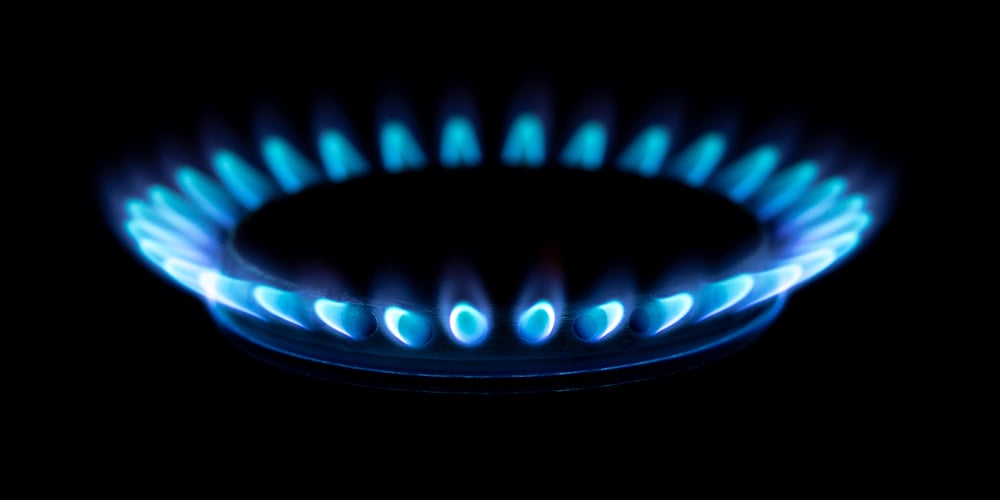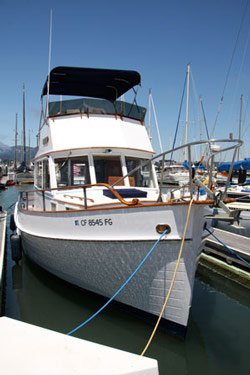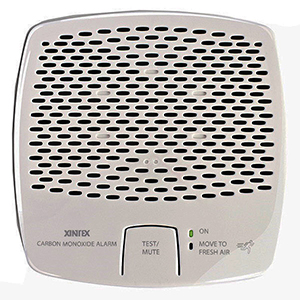

This 32' Grand Banks trawler has multiple fuel-burning devices that all need maintenance for safe operation. A CO detector is important insurance in case something goes wrong.
The Danger of Carbon Monoxide on Boats
Carbon Monoxide (CO) is a silent killer on houseboats and other recreational vessels. Each year, boaters are killed or injured by carbon monoxide, and virtually all of these poisonings are preventable. We’ll discuss monitoring devices to alert you to this danger, but first, we remind boaters that regular maintenance of your boat’s mechanical systems and proper operation of your boat are the best defenses against carbon monoxide.
CO is created as a result of incomplete combustion in appliances like gas powered electrical generators, propane stoves, heaters or a boat's internal combustion engine. CO gas is odorless, tasteless, initially non-irritating but can be deadly. Because CO is lighter than propane or gasoline vapor, without smell or taste, its presence remains undetected by humans until symptoms of exposure set in.
Exposure to CO is possible in enclosed or poorly ventilated spaces where exhaust from a gasoline or diesel engine, generator or open flame from a fueled cabin heater or galley appliance can collect. Exposure time and concentration levels determine what effect, if any, this exposure has on our bodies. Amounts over 100 parts per million are dangerous to human health. CO is easily absorbed in the bloodstream (combining with hemoglobin 200 times more easily than oxygen) where it reduces the blood's oxygen carrying ability, leading to hypoxia and causing "suffocation" of the victim. Typical symptoms of CO exposure could easily be mistaken for seasickness because they trigger dizziness and nausea. We think this alone warrants the investment in a good CO detector on any boat.
If you or a crew member are showing signs of CO poisoning, immediately move the victim to a location with fresh air. It is a good idea to shut down all possible sources of CO before determining next steps. Acute exposure to CO is classified as a medical emergency and should be treated at a hospital.
Symptoms of CO Poisoning
The rate at which CO is absorbed into the bloodstream depends on its ambient concentration and a person's length of exposure. The table below lists symptoms of CO poisoning which can vary from a slight headache to death.
| 100 ppm | .01% | Slight headache in two to three hours |
| 200 ppm | .02% | Slight headache within two to three hours; loss of judgement |
| 400 ppm | .04% | Frontal headache within one to two hours |
| 800 ppm | .08% | Dizziness, nausea and convulsions within 45 minutes. Insensible in two hours. |
| 1,600 ppm | .16% | Headache, dizziness and nausea within 20 minutes. Death in less than two hours. |
| 3,200 ppm | .32% | Headache, dizziness and nausea in five to ten minutes. Death within 30 minutes. |
| 6,400 ppm | .64% | Headache and dizziness in one to two minutes. Death in less than 20 minutes. |
| 12,800 ppm | 1.28% | Death in less than three minutes. |
U.S. Coast Guard’s Tips to Avoid CO Overexposure
- Operate combustion devices (stoves, heaters, generators) in well-ventilated areas.
- Supplement natural ventilation with fans or forced air. Keep forward-facing hatches open to allow fresh air circulation in accommodation spaces, even in inclement weather.
- Close the hatches and set your course away from the path of exhaust fumes when motoring downwind in a following sea.
- Install CO detectors in each cabin. It’s the most effective defense against a potentially fatal problem.
- Avoid any activity on the rear deck, swim platform, and around exhaust pipes while the engine or generator is running.
- CO exposure danger also exists on deck, especially when a boat idles at the dock or seawall where exhaust can accumulate. Even when not running your engine, beware of CO accumulation from other boats that idle at the dock to windward.

CO Detectors can be wired to your boat's DC 12-volt system or are battery operated.
Inspect Your Boat for CO Hazards
Each Trip
Take the following actions whenever you use your boat. Do not operate the vessel if any of these problems exist!
- Make sure you know where CO exhaust outlets are located on your vessel.
- Educate all passengers about the symptoms of CO poisoning and where CO may accumulate.
- When docked or rafted with another boat, be aware of exhaust emissions from the other boat.
- Confirm that cooling water flows from the wet exhaust outlet when the engine or generator is started.
- Listen for any change in exhaust sound that could indicate a failure of an exhaust component.
- Test the operation of each carbon monoxide detector by pressing the test button.
Once a Month
- Make sure all exhaust clamps are in place and secure.
- Look for exhaust leaking from exhaust system components. Signs include rust and/or black streaking, water leaks, or corroded or cracked fittings.
- Inspect rubber exhaust hoses for burned, cracked or deteriorated sections. All rubber hoses should be pliable and free of kinks.
Annually by a Qualified Marine Technician
- Replace exhaust hoses if any evidence is found of cracking, charring or deterioration.
- Ensure that your engines and generators are properly tuned and well maintained.
- Inspect each water pump impeller and check the condition of the water pump housing. Replace if necessary.
- Inspect each of the metallic exhaust components for cracks, rust, leaks or looseness. Pay particular attention to the cylinder head, exhaust manifold and water injection elbow.
- Clean, inspect and confirm proper operation of the generator cooling water anti-siphon valve (if equipped).
What to Look for in CO Detectors
Time-weighted averaging: As of 2010 a carbon monoxide detector must meet the ANSI/UL 2034-2005 standard, and it should compute the time-weighted average of the CO concentration in the air. The time-weighted average measurement process constantly monitors all CO levels, eliminating most false alarms.
Multi-channel monitoring: This function allows detectors to measure fumes in different cabins. For example, the carbon monoxide detectors CMD5-MD-R allows up to ten detectors to be linked together. When one detector’s alarm activates, all connected detectors will alarm to alert boat inhabitants in other locations to the presence of CO.
Sensitivity: CO alarms will sound when they measure 70 particles of carbon monoxide per one million particles of air (PPM), well before the first symptoms of overexposure set in.
Sensor mounting position: Install carbon monoxide detectors or remote sensors at or near eye level in each cabin but NOT near a hatch or porthole where water could come in contact with the device.
More Information
For more about carbon monoxide poisoning and what you can do to prevent it, read Carbon Monoxide Poisoning a Dangerous Combination, which orginally appeared in United States Coast Guard Boating Safety Circular 86.